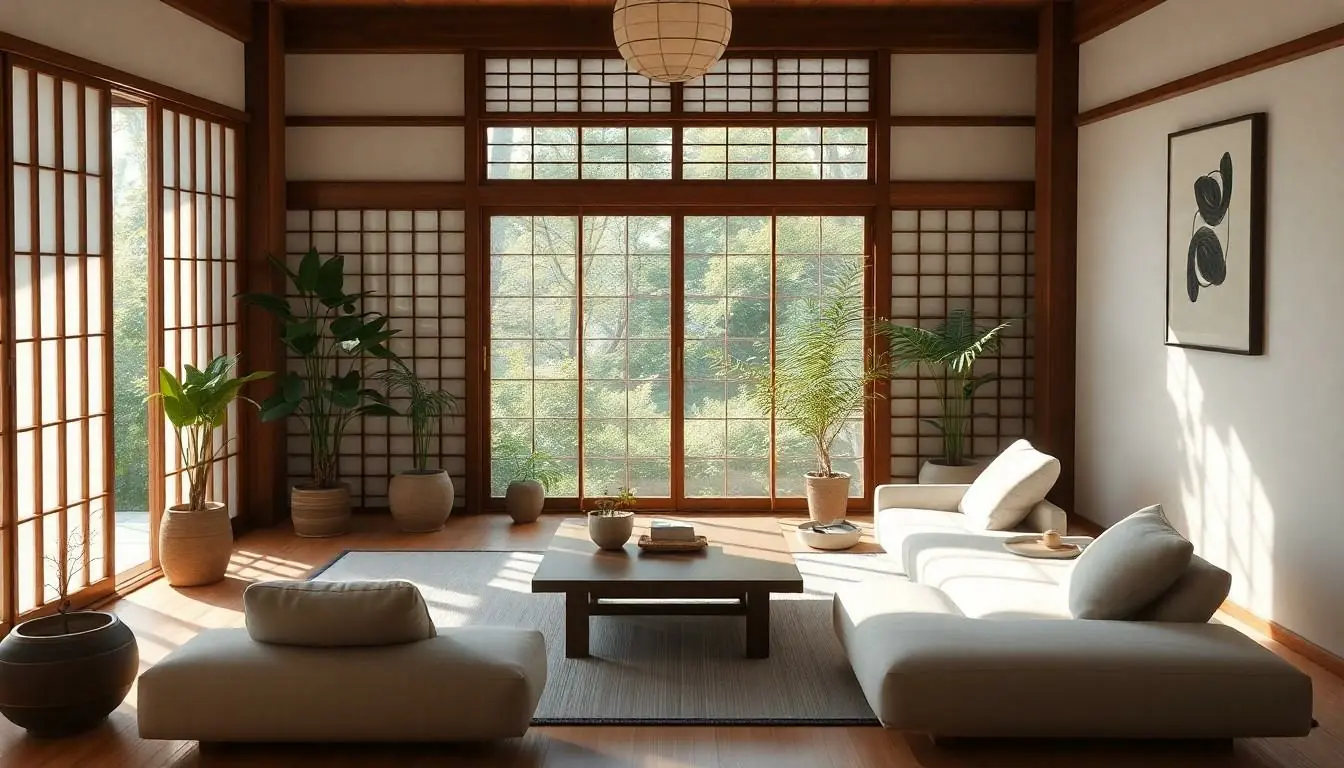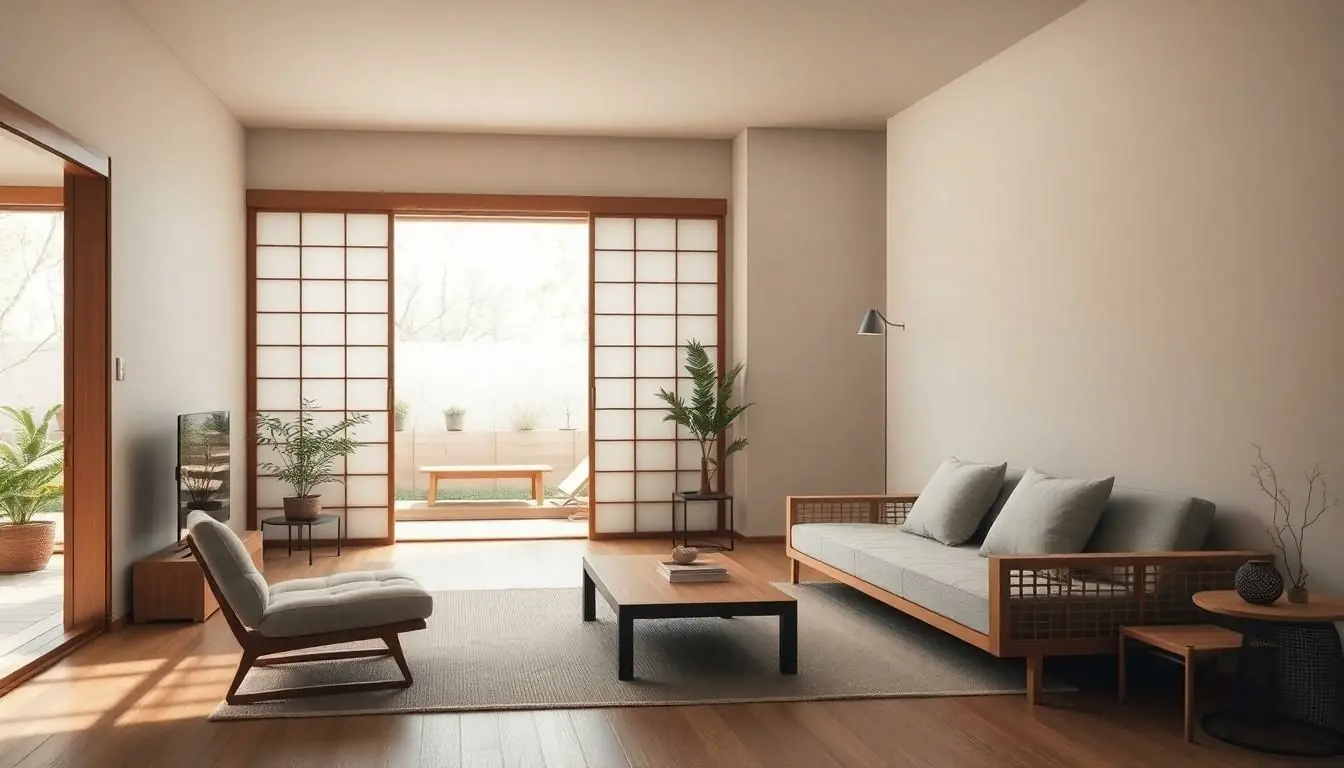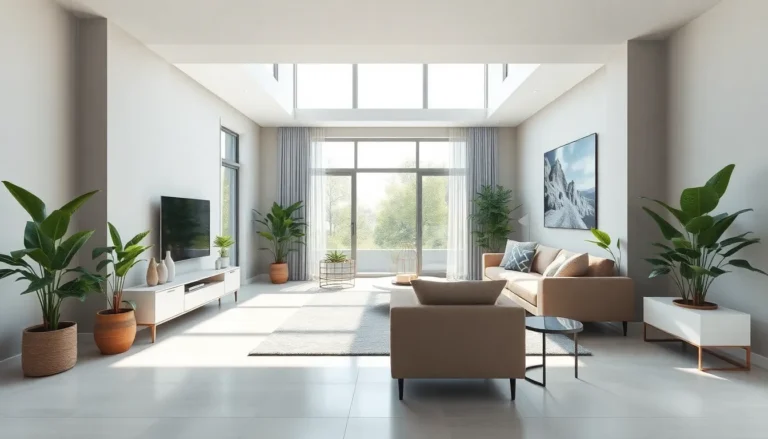Table of Contents
ToggleStep into the serene world of Japanese style interior design, where simplicity meets elegance and every corner whispers tranquility. Imagine a space that feels like a warm hug from a cozy blanket, yet looks like it belongs in a high-end magazine. This design philosophy isn’t just about aesthetics; it’s a lifestyle that promotes harmony, balance, and a touch of Zen.
Overview of Japanese Style Interior Design
Japanese style interior design emphasizes minimalism and natural elements to create calm spaces. This design approach often incorporates essential features such as open floor plans and traditional tatami flooring. Natural materials like wood and stone play a significant role, enhancing the connection between indoors and outdoors.
Color palettes generally consist of neutral tones paired with delicate hues. Soft whites, beiges, and greens promote tranquility. Spaces often highlight light through large windows or sliding doors, allowing natural light to flow in seamlessly.
Furniture selections prioritize function over form, showcasing clean lines and simple designs. Low-profile furniture pieces are common, providing a grounded feel. In addition, handmade items or artisanal crafts add personality and warmth to rooms.
Japanese gardens frequently influence interior layouts. Incorporating plants or small water features creates serene environments within homes. Elements such as shoji screens enable flexible room configurations while maintaining privacy and elegance.
Art pieces often reflect traditional Japanese aesthetics, focusing on nature and seasonal themes. Calligraphy, paintings, or ceramics showcase the beauty of imperfection, aligning with the Wabi-Sabi philosophy. Spiritual elements, such as Zen gardens or Buddhist influences, further enhance the peaceful atmosphere.
Overall, Japanese style interior design transcends mere decoration, promoting a lifestyle rich in mindfulness and reflection.
Key Principles of Japanese Design


Japanese interior design focuses on essential principles that create serene, balanced spaces. These principles intertwine to promote harmony and tranquility.
Minimalism and Simplicity
Minimalism stands at the core of Japanese design. Uncluttered spaces enhance relaxation and create a peaceful atmosphere. Clean lines define furniture, highlighting function over form. Spaces often feature low-profile designs, allowing for fluid movement. Neutral tones dominate color palettes, complemented by subtle hues. Purposeful selections, such as handmade items, introduce personal warmth without overwhelming the eye. Each element serves a specific purpose, reinforcing a sense of calm. Simplicity encourages an appreciation for craftsmanship and quality over quantity, aligning with the philosophy of Wabi-Sabi.
Nature Integration
Nature plays a pivotal role in Japanese interior design. Natural materials like wood and stone establish a strong connection to the outdoors. Sunlight fills spaces, blurring the lines between interior and exterior. Plants often serve as focal points, while small water features promote tranquility. Elements like shoji screens allow for flexible layouts that adapt to changing needs. Seasonal changes influence decor, celebrating nature’s cycles. Garden-inspired interiors create a sense of harmony, integrating life and art seamlessly. Emphasis on nature fosters a calming environment conducive to mindfulness and reflection.
Essential Elements of Japanese Interiors
Japanese interiors rely on specific design elements that emphasize simplicity and tranquility. Key components create a harmonious atmosphere in homes and spaces.
Tatami Mats and Shoji Screens
Tatami mats serve as traditional flooring, crafted from rice straw and woven rush grass. They provide a unique texture and comfort underfoot, establishing a natural aesthetic in living areas. Shoji screens consist of wooden frames filled with translucent paper, allowing soft, diffused light to enter while maintaining privacy. These screens often divide spaces, creating flexible room layouts that enhance functionality without compromising serenity.
Fusuma and Noren
Fusuma are sliding doors, traditionally painted with nature-inspired motifs. They offer a way to separate rooms or create an open space, blending seamlessly with the overall design. Noren, fabric dividers hung in doorways, add a touch of color and artistry to interiors. Used in kitchens and entryways, they serve both decorative and functional purposes while fostering a mindful transition between spaces.
Color Palette and Materials
Japanese style interior design emphasizes a harmonious connection between color palettes and materials. Choices reflect a deep respect for nature, creating serene spaces that promote tranquility.
Natural Materials
Wood and stone dominate the landscape of Japanese interiors. Traditional elements, including tatami mats and sliding shoji screens, showcase natural textures. Incorporating bamboo and cork enhances warmth and comfort in spaces. These materials foster a sense of authenticity and sustainability. Handmade furniture adds character and uniqueness, reinforcing a connection to craftsmanship. Natural materials invite the beauty of the outdoors inside, creating inviting and calming environments.
Earthy and Neutral Tones
Earthy and neutral tones serve as a foundation for Japanese design aesthetics. Shades of beige, taupe, and soft greens create a relaxed atmosphere. These colors allow natural light to enhance the overall space, promoting warm ambiance. Accent colors, such as deep browns and muted grays, can be integrated through textiles and accessories. Utilizing these hues encourages a sense of balance and calmness. Inviting subtle variations accentuates the simplicity and elegance inherent in Japanese style.
Furniture and Decor
Japanese style interior design harmonizes functionality and aesthetics, featuring furniture and decor that reflect simplicity and elegance.
Traditional vs. Modern Styles
Traditional Japanese interiors often incorporate natural materials and handcrafted items, such as tatami mats and low tables. These elements promote a serene space that allows for easy meditation and relaxation. In contrast, modern styles blend traditional techniques with contemporary designs, resulting in innovative furniture pieces and decor. Open floor plans accommodate flexible living, integrating natural light and greenery into daily life. Each approach emphasizes minimalism, with clean lines dominating furniture styles. Traditional spaces showcase intricate details, while modern designs prioritize simplicity and open spaces.
Functional and Aesthetic Balance
Furniture selections in Japanese design highlight the importance of balance between function and aesthetics. Low-profile seating encourages comfort without sacrificing visual appeal. Handmade items often take center stage, adding character and warmth to the environment. Natural materials like wood and stone play a pivotal role, enhancing the connection to nature. Decor items, including art and textiles, complement the overall design while serving specific purposes. Every piece contributes to the tranquility of the space, maintaining a feeling of calm. The strategic use of color and texture aligns with the principles of Wabi-Sabi, celebrating imperfection and simplicity.
Japanese style interior design offers a unique approach that harmonizes simplicity with elegance. By prioritizing natural materials and minimalism, it creates serene spaces that promote relaxation and mindfulness. The careful integration of indoor and outdoor elements fosters a tranquil atmosphere that resonates with nature.
This design philosophy not only enhances the aesthetic appeal of a home but also encourages a lifestyle centered on balance and reflection. Whether through traditional tatami mats or modern interpretations, the essence of Japanese design remains rooted in its ability to inspire calmness and clarity. Embracing these principles can transform any space into a sanctuary of peace and beauty.


